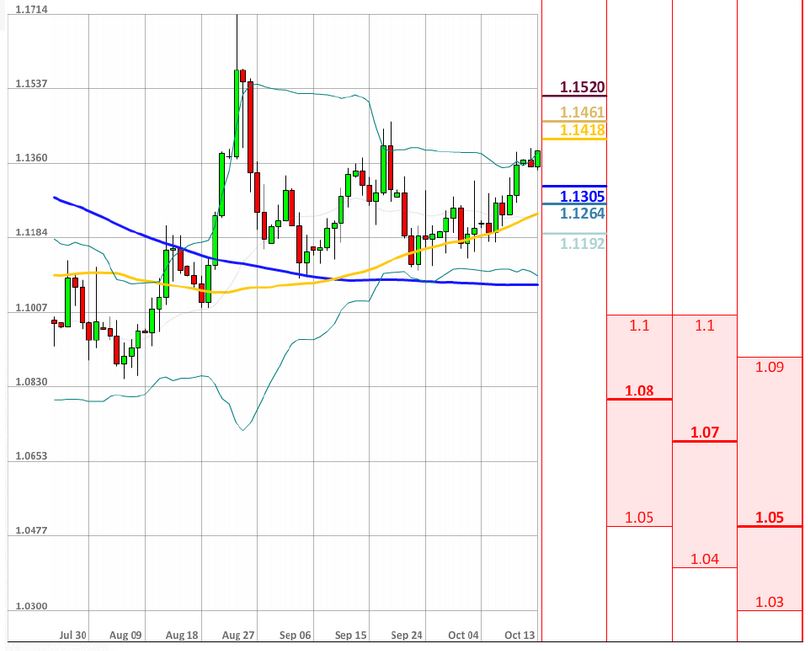Euro Exchange Rates: EURUSD Knocking on the Door of 1.14
The euro to dollar exchange rate is on the cusp of advancing through the 1.14 barrier, but this level will prove incredibly hard to breach.
But, could today be the day when EURUSD finally breaks through this psychologically challenging level? According to analyst Karen Jones at Commerzbank, the answer would be yes:
"EUR/USD is capable of extending gains near term into the much tougher resistance offered by the 1.1440/68 band, where the May, June and September highs were made.
"Above here lies the 55 week ma at 1.1472 and the 2014-2015 downtrend at 1.1468, we would ideally expect this to hold the topside and provoke failure."
Contending that the 1.14 point will be a tough nut to crack is a recent analysis from Dukascopy who have looked at the charts and noted the formation of an exotically named technical signal suggesting downside risks are growing.
Analysts note:
"After yesterday's session we now have an additional bearish signal, which is a gravestone doji. We expect the resistance at 1.14 to withstand the buying pressure and send the price lower.
"The nearest significant support is 1.13, represented by the weekly pivot point. This level, however, is unlikely to underpin the pair. EUR/USD should bottom out lower. The first potential reversal point will be the monthly PP at 1.1250, followed by the 55-day SMA at 1.12."
However, a foreign exchange briefing issued by Lloyds Bank fancies the EURUSD to advance beyond 1.14 this break now leaves the exchange rate at risk of a further grind towards the 1.1460 September high.
Nevertheless, the euro exchange rate complex seems to always be on the winning team in the present environment.
The EUR exhibited some safe-haven attractiveness during August and September’s market volatility, and has also benefitted from a broader unwind of long USD bets.
The nature of the 'safe-haven' attractiveness may be better explained via the observation that many bets on global equity and commodity markets will have been funded with euros - as investors unwound exposure to these high risk assets the shared currency would be an obvious beneficiary.
It is worth pointing out that even as markets rise on the back of better risk sentiment the euro is still managing to find demand.
Thus there is also the argument to be made that euro strength is largely a function of weakness elsewhere.
Downside risks for the shared currency from the European Central Bank (ECB) are still elevated though and this subject will ultimately decide whether significant weakness will play out in coming weeks.
The euro to dollar exchange rate climbed to 1.1378 from 1.1354 as Mario Draghi suggested that ECB’s quantitative-easing program is working well, decreasing the likelihood of additional easing.
The ECB has made it clear that it stands ready to expand its quantitative easing programme if its inflation mandate comes under renewed threat.
The current trend of ECB speak seems focused on breaking the market’s view that more easing is a forgone conclusion.
However, subdued European data suggest that an extension of current program is in fact likely.
But for now, ECB officials seem comfortable that core inflation (which excludes oil prices) remains relatively steady.
"We see EUR at 1.14 at year-end (prev. 1.05), but down to 1.07 by end-2016 as the Fed hikes and the ECB continues to ease," says a note from ANZ Research on the 12th of October.
ANZ join a number of other institutional forecasters that have opted to revise higher their euro outlook in the face of the continued strength in the shared currency.
Momentum indicators confirm upside is preferred in the near-term.
According to Yann Quelenn, Market Strategist with Swissquote Bank:
"The EUR/USD has moved sharply higher and is now consolidating. Hourly resistance can be found at 1.1460 (18/09/2015 high).
"Support can be found at 1.1087 (03/09/2015 low). Stronger support lies at 1.1017 (18/08/2015 low)."
In the longer term, Quelenn argues that the symmetrical triangle from 2010-2014 favored further weakness towards parity.
"As a result, we view the recent sideways moves as a pause in an underlying declining trend. Key supports can be found at 1.0504 (21/03/2003 low) and 1.0000 (psychological support). We remain in a downside momentum," suggests the analyst.





